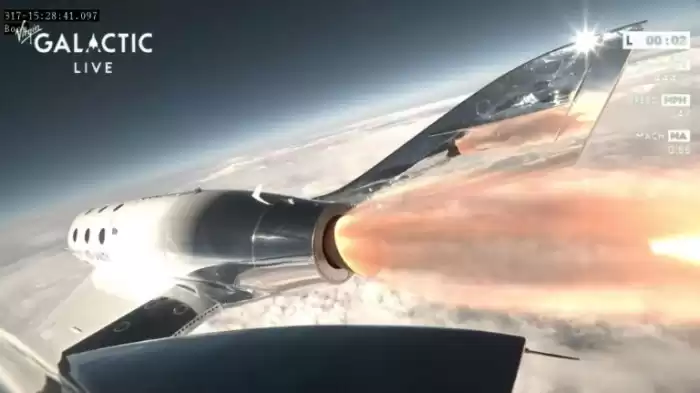Virgin Galactic rockets tourist passengers into space
Virgin Galactic successfully launched its first tourist passengers into space, marking a major milestone in the company's pursuit of space tourism. The three passengers experienced weightlessness and admired views of Earth and space before safely landing in New Mexico. This achievement fulfills a nearly two-decade-old promise by founder Richard Branson to bring tourists into space. The flight also establishes Virgin Galactic as a competitor in the suborbital space tourism sector.
Virgin Galactic successfully launched its first group of tourist passengers into space on Thursday, marking a major milestone in the company's nearly two-decade pursuit of commercial space travel. The three passengers, Jon Goodwin, Keisha Schahaff, and her daughter Anastatia Mayers, experienced weightlessness as they floated through the Virgin spacecraft after reaching an altitude of 80 kilometers (50 miles), officially entering space. The live video feed showed the passengers marveling at the breathtaking views of Earth and space from the windows of the spacecraft.
The flight lasted approximately 45 minutes, with the spacecraft safely landing in New Mexico, where it had initially taken off. The experience was described as the most exciting day of Jon Goodwin's life, who at 80 years old, had competed in the 1972 Olympic Games as a canoeist for Britain. He expressed his awe at the pure acceleration and the surreal experience of reaching Mach-3 in just eight-and-a-half seconds. Anastatia Mayers, at 18 years old, became the youngest person ever to go into space, adding to the significance of the achievement.
This successful launch was the realization of a long-held dream of space tourism by British billionaire Richard Branson, the founder of Virgin Galactic. The company's spaceflights involve a carrier aircraft that takes off from a runway, gains altitude, and then releases a rocket-powered spaceplane that continues its ascent. This particular mission, named Galactic 02, was the second commercial flight for Virgin Galactic, following a previous flight that carried a group of senior Italian Air Force officers conducting experiments on board.
Virgin Galactic, founded in 2004, has already sold around 800 tickets for future commercial flights, with prices ranging from $200,000 to $250,000 between 2005 and 2014, and $450,000 each since then. Jon Goodwin, who reserved his seat in 2005, had his hopes dampened by a Parkinson's Disease diagnosis but was ultimately chosen as the first paying passenger for the program. Keisha Schahaff and Anastatia Mayers won their tickets through a charity raffle organized by Virgin Galactic. Schahaff, a 46-year-old health coach from Antigua and Barbuda, expressed her surprise at the profound connection she felt to everything during the flight, stating that it has motivated her to explore and be even more adventurous.
Richard Branson, who watched the flight remotely from Antigua and Barbuda, where he joined the families of Schahaff and Mayers, expressed his joy and pride in witnessing the successful launch. Virgin Galactic's entry into the suborbital space tourism sector puts it in competition with Jeff Bezos's company, Blue Origin, which has already sent 31 people into space using a vertical lift-off rocket. However, Blue Origin's rocket has been grounded since an accident during an unmanned flight in September 2022. The company has promised to resume spaceflight soon, intensifying the competition in the commercial space travel industry.











Comments on Virgin Galactic rockets tourist passengers into space